The AMD Radeon R9 295X2 Review
by Ryan Smith on April 8, 2014 8:00 AM EST- Posted in
- GPUs
- AMD
- Radeon
- Radeon 200
Compute
Our final set of performance benchmarks is compute performance, which for dual-GPU cards is always a mixed bag. Unlike gaming where the somewhat genericized AFR process is applicable to most games, when it comes to compute the ability for a program to make good use of multiple GPUs lies solely in the hands of the program’s authors and the algorithms they use.
At the same time while we’re covering compute performance for completeness, the high price and unconventional cooling apparatus for the 295X2 is likely to deter most serious compute users.
In any case, our first compute benchmark is LuxMark2.0, the official benchmark of SmallLuxGPU 2.0. SmallLuxGPU is an OpenCL accelerated ray tracer that is part of the larger LuxRender suite. Ray tracing has become a stronghold for GPUs in recent years as ray tracing maps well to GPU pipelines, allowing artists to render scenes much more quickly than with CPUs alone.
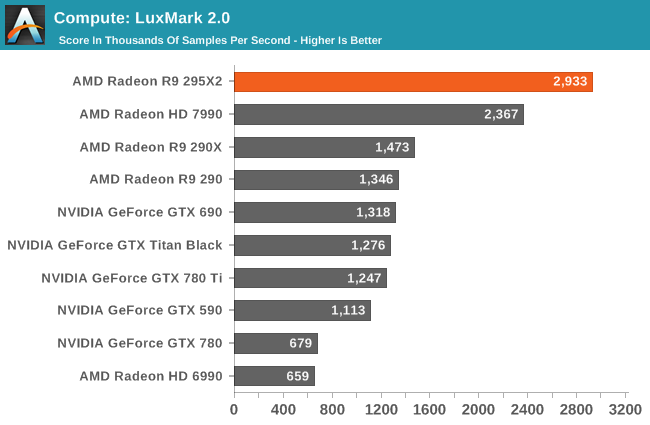
As one of the few compute tasks that’s generally multi-GPU friendly, ray tracing is going to be the best case scenario for compute performance for the 295X2. Under LuxMark AMD sees virtually perfect scaling, with the 295X2 nearly doubling the 290X’s performance under this benchmark. No other single card is currently capable of catching up to the 295X2 in this case.
Our second compute benchmark is Sony Vegas Pro 12, an OpenGL and OpenCL video editing and authoring package. Vegas can use GPUs in a few different ways, the primary uses being to accelerate the video effects and compositing process itself, and in the video encoding step. With video encoding being increasingly offloaded to dedicated DSPs these days we’re focusing on the editing and compositing process, rendering to a low CPU overhead format (XDCAM EX). This specific test comes from Sony, and measures how long it takes to render a video.
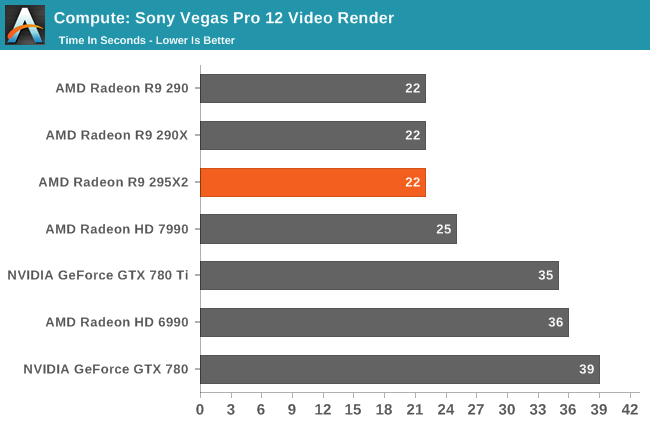
Sony Vegas Pro on the other hand sees no advantage from multiple GPUs. The 295X2 does just as well as the other Hawaii cards at 22 seconds, sharing the top of the chart, but the second GPU goes unused.
Our third benchmark set comes from CLBenchmark 1.1. CLBenchmark contains a number of subtests; we’re focusing on the most practical of them, the computer vision test and the fluid simulation test. The former being a useful proxy for computer imaging tasks where systems are required to parse images and identify features (e.g. humans), while fluid simulations are common in professional graphics work and games alike.
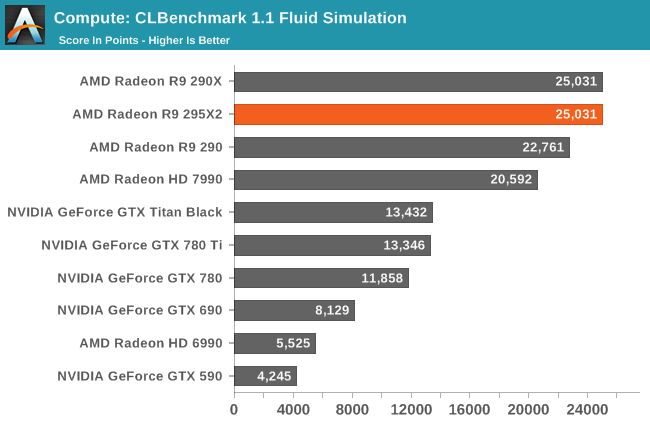

Like Vegas Pro, the CLBenchmark sub-tests we use here don't scale with additional GPUs. So the 295X2 can only match the performance of the 290X on these benchmarks.
Moving on, our fouth compute benchmark is FAHBench, the official Folding @ Home benchmark. Folding @ Home is the popular Stanford-backed research and distributed computing initiative that has work distributed to millions of volunteer computers over the internet, each of which is responsible for a tiny slice of a protein folding simulation. FAHBench can test both single precision and double precision floating point performance, with single precision being the most useful metric for most consumer cards due to their low double precision performance. Each precision has two modes, explicit and implicit, the difference being whether water atoms are included in the simulation, which adds quite a bit of work and overhead. This is another OpenCL test, as Folding @ Home has moved exclusively to OpenCL this year with FAHCore 17.
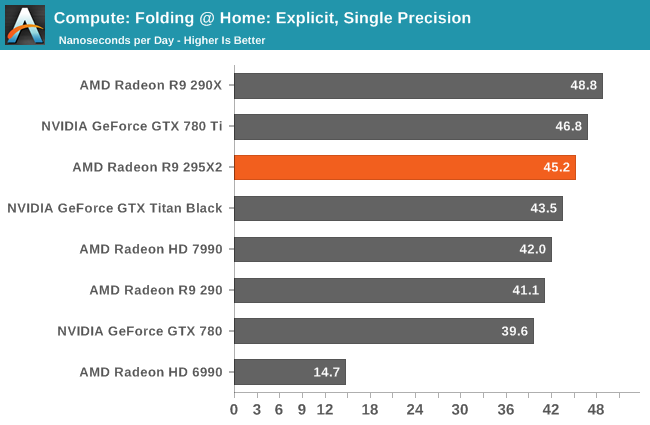
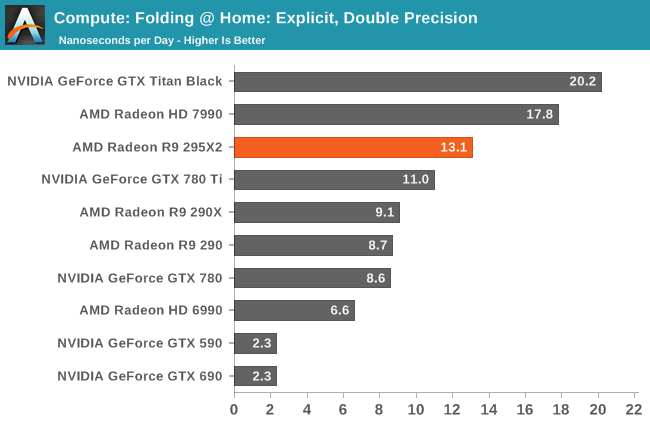
Unlike most of our compute benchmarks, Folding@Home does see some degree of multi-GPU scaling. However the outcome is really a mixed bag; single-precision performance ends up being a wash (if not a slight regression) while double-precision is seeing sub-50% scaling.
Wrapping things up, our final compute benchmark is an in-house project developed by our very own Dr. Ian Cutress. SystemCompute is our first C++ AMP benchmark, utilizing Microsoft’s simple C++ extensions to allow the easy use of GPU computing in C++ programs. SystemCompute in turn is a collection of benchmarks for several different fundamental compute algorithms, as described in this previous article, with the final score represented in points. DirectCompute is the compute backend for C++ AMP on Windows, so this forms our other DirectCompute test.
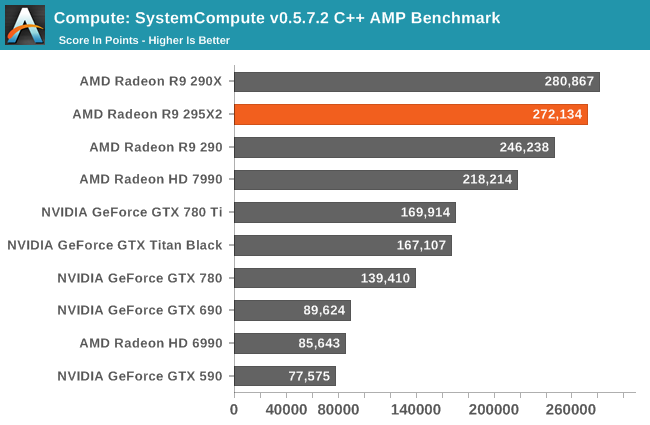
Our final compute benchmark has the 295X2 and 290X virtually tied once again, as this is another benchmark that doesn’t scale up with multiple GPUs.










131 Comments
View All Comments
Smartgent - Tuesday, April 8, 2014 - link
The card is watercooled!! not aircooled like Nividia chose to do with their 500W TitanZ. Ishould run very quiet, and should not affect your internal temps much, as long as you mount the radiator externally to your case.Ian Cutress - Tuesday, April 8, 2014 - link
It's a shame they're not making a version with a larger liquid cooler. Would like to see it with a 2x120 CLC and an overclock.jtd871 - Tuesday, April 8, 2014 - link
This card should have just been released with a full-cover block and let the enthusiasts/3rd-parties use whatever custom cooling they like.Rambon3 - Tuesday, April 8, 2014 - link
Great article. I wish I had a spare grand and a half to replace my 7970 CF set up. BTW It looks like you have an extra GPU Load temp chart on Page 17 where the Load noise chart should be positioned.randomhkkid - Tuesday, April 8, 2014 - link
I may have missed it in the article but I don't think you mentioned whether or not it would be possible to add an additional fan on that asutek cooler? This would surely bring down stock temperatures (albeit increase the noise) if one was thinking about overclocking further.Ryan Smith - Tuesday, April 8, 2014 - link
Yes, it's possible. You would need to come up with a matching fan and the screws to mount it, but there's nothing from a hardware perspective keeping you from mounting a second fan for push-pull. I don't know if it's easily visible in our pictures, but the fan power connector is exposed mid-way along the cable run, so you can split it there to get a second fan power header.mpdugas - Tuesday, April 8, 2014 - link
push-pull, perhaps?Gunbuster - Tuesday, April 8, 2014 - link
The perfect card for high resolution multi monitor rigs, oh wait frame pacing is still broken. Don't worry, just send in your $1500 and they'll fix it sometime in 2015 (maybe)JDG1980 - Tuesday, April 8, 2014 - link
Pay closer attention to the article. Frame pacing is still imperfect *on the old 7990*, not on the R9 295X2. It works fine on GCN 1.1 cards (290/290X/295X2) due to the new XDMA engine.Admittedly, it was odd for them to throw in some 7990 bashing in the review of a new card, so I can understand the confusion.
Mondozai - Tuesday, April 8, 2014 - link
Why are you asking people to pay attention to articles they are commenting on?This is the internet.